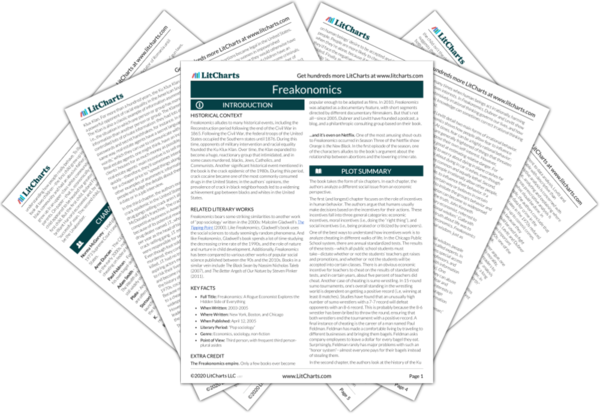More than half of the chapters of Freakonomics take some form of crime as their subject. Throughout the book, the authors use case studies of crime as examples of important economic principles. But crime is more than just an illustration of economic ideas—it’s an important theme of Freakonomics in its own right. In general, the authors’ impartial, behavioral arguments have the effect of removing the stigma of crime and humanizing criminals.
One of the authors’ most important points about crime is that crime can be a rational behavior. For people who live in impoverished neighborhoods with few job opportunities, crime can be the best way to lead a productive, happy life. Thus, people often turn to crime because of their ambition, intelligence, and optimism, not because of their innate “badness,” as conventional wisdom would have it. Indeed, close analysis of criminal practices like the drug trade reveals the sale of crack cocaine to be structurally identical to the sale of McDonald’s hamburgers. As the authors show, criminals “manage” drug gangs in the same way that managers run fast food franchises. The shallow stereotype that criminals are innately bad people neglects an important economic truth: people respond to incentives. Often, criminals are simply responding to economic incentives to steal, sell drugs, etc., just as other people respond to economic incentives to pay taxes, go to work, etc.
Even when crime isn’t an entirely rational behavior, it still has a lot in common with ordinary, law-abiding behavior. Crime is dangerous, and many criminals lose their lives while breaking the law—a fact which leads many people to conclude that criminals must be somehow inhuman or suicidal. But, as economic analysis can verify, criminals risking their lives to sell drugs aren’t very different from aspiring actors moving to Hollywood, or dedicated weight lifters who wake up at dawn to train. In all three cases, humans have the capacity to sacrifice their own happiness and safety for the sake of their ambitions (becoming a powerful drug kingpin, a movie star, or Mr. Universe, respectively).
In general, the scientific methods and impartial tone of Freakonomics suggest an important conclusion about crime: crime isn’t inherently evil; on the contrary, it’s often a normal human response to a harsh economic situation.
Crime ThemeTracker

Crime Quotes in Freakonomics
And the millions of women most likely to have an abortion in the wake of Roe v. Wade—poor, unmarried, and teenage mothers for whom illegal abortions had been too expensive or too hard to get—were often models of adversity. They were the very women whose children, if born, would have been much more likely than average to become criminals. But because of Roe v. Wade, these children weren't being born. This powerful cause would have a drastic, distant effect: years later, just as these unborn children would have entered their criminal primes, the rate of crime began to plummet.
Is it possible, then, that an 8-6 wrestler might allow a 7-7 wrestler to beat him? A sumo bout is a concentrated flurry of force and speed and leverage, often lasting only a few seconds. It wouldn’t be very hard to let yourself be tossed.
So how did the gang work? An awful lot like most American businesses, actually, though perhaps none more so than McDonald's. In fact, if you were to hold a McDonald's organizational chart and a Black Disciples org chart side by side, you could hardly tell the difference.
So if crack dealing is the most dangerous job in America, and if the salary was only $3.30 an hour, why on earth would anyone take such a job?
Well, for the same reason that a pretty Wisconsin farm girl moves to Hollywood. For the same reason that a high-school quarterback wakes up at 5 a.m. to lift weights. They all want to succeed in an extremely competitive field in which, if you reach the top, you are paid a fortune (to say nothing of the attendant glory and power).
DuPont had pulled off the feat that every marketer dreams of: it brought class to the masses. In this regard, the invention of nylon stockings was markedly similar to the invention of crack cocaine.
First, the drop in crime in New York began in 1990. By the end of 1993, the rate of property crime and violent crime, including homicides, had already fallen nearly 20 percent. Rudolph Giuliani, however, did not become mayor … until early 1994.
Growing up in a single-parent home roughly doubles a child’s propensity to commit crime. So does having a teenage mother. Another study has shown that low maternal education is the single most powerful factor leading to criminality.
In other words, the very factors that drove millions of American women to have an abortion also seemed to predict that their children, had they been born, would have led unhappy and possibly criminal lives.
So even for someone who considers a fetus to be worth only one one-hundredth of a human being, the trade-off between higher abortion and lower crime is, by an economist's reckoning, terribly inefficient.
The second child, now twenty-eight years old, is Roland G. Fryer Jr., the Harvard economist studying black underachievement.
The white child also made it to Harvard. But soon after, things went badly for him. His name is Ted Kaczynski.
















